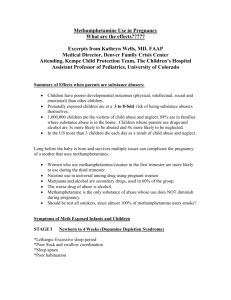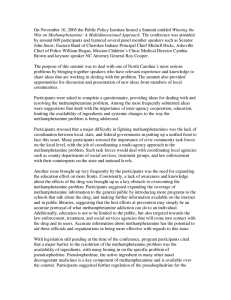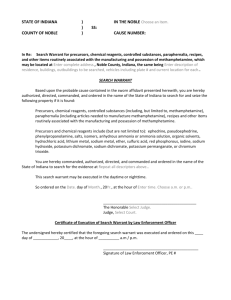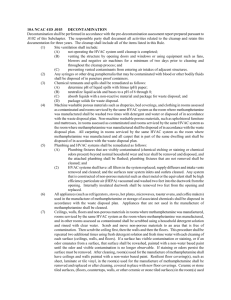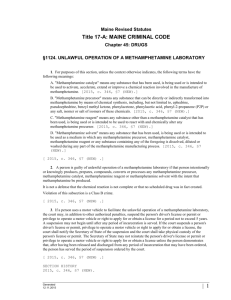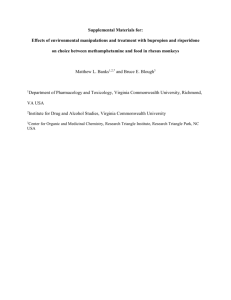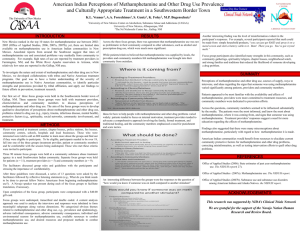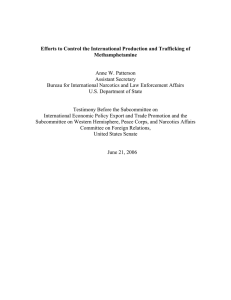Appendix S1. GCMS parameters for analysis of SPME and
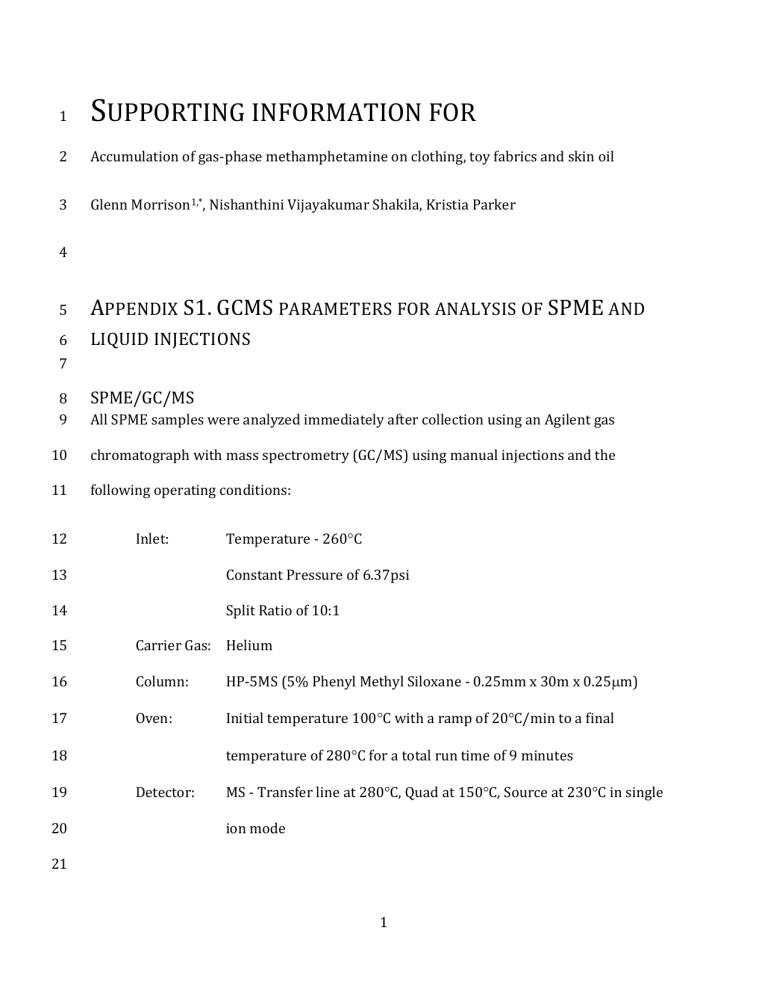
1
2
S
UPPORTING INFORMATION FOR
Accumulation of gas-phase methamphetamine on clothing, toy fabrics and skin oil
3 Glenn Morrison 1,* , Nishanthini Vijayakumar Shakila, Kristia Parker
4
12
13
14
15
16
17
18
19
20
21
10
11
5
6
7
8
9
A
PPENDIX
S1.
GCMS
PARAMETERS FOR ANALYSIS OF
SPME
AND
LIQUID INJECTIONS
SPME/GC/MS
All SPME samples were analyzed immediately after collection using an Agilent gas chromatograph with mass spectrometry (GC/MS) using manual injections and the following operating conditions:
Inlet: Temperature - 260 C
Constant Pressure of 6.37psi
Split Ratio of 10:1
Carrier Gas: Helium
Column: HP-5MS (5% Phenyl Methyl Siloxane - 0.25mm x 30m x 0.25
m)
Oven: Initial temperature 100 C with a ramp of 20 C/min to a final temperature of 280 C for a total run time of 9 minutes
Detector: MS - Transfer line at 280 C, Quad at 150 C, Source at 230 C in single ion mode
1
30
31
32
33
34
35
36
37
38
39
40
41
22 The fiber was left in the injection port for 5 minutes for each sample.
23
S
UBSTRATE ANALYSIS BY LIQUID EXTRACTION AND CALIBRATION
24
25
26
27
28
29
Immediately upon being removed from the chamber the samples were placed into a 7.0mL vial and then 6.5mL of ethylacetate was added to the vial. The vial was sonicated for 20 minutes before the extract was filtered through a nylon 0.2
m syringe filter into a separate
7.0mL vial. A 1.0mL aliquot of the extracts along with 10 L of a 1,000ppm BFB solution in ethyl acetate was transferred to a 2.0mL GC vial. Each sample was analyzed immediately after sample extraction using an Agilent GCMS with the following operating conditions:
Inlet: Injection volume – 1 L
Temperature - 250 C
Constant Pressure of 3.94psi
Split Ratio of 40:1
Carrier Gas: Helium
Column: HP-5MS (5% Phenyl Methyl Siloxane – 0.25mm x 30m x 0.25
m)
Oven: Initial temperature of 50 C – hold for 4 minutes and then ramp at a rate of 20 C/min to a final temperature of 250 C for a total run time of
14 minutes
Detector: MS – Transfer line at 280 C, Quad at 150 C, Source at 230 C in single ion mode
2
42
43
A
PPENDIX
S2.
CHARACTERISTIC TIME DISCUSSION
48
49
50
51
52
44
45
46
47
53
54
59
60
61
62
55
56
57
58
63
We believe most of the materials are nearly at equilibrium by the end of these experimental exposures, even though it may not be obvious from the dynamic charts (Figures 2a, 2b and
S.2). The system is somewhat complex because the chamber concentration is initially lower than the inlet concentration, due to flux to the material surfaces. Over time, the chamber concentration rises as the materials approach the limit of their capacity to sorb methamphetamine. An estimate of the characteristic time to reach equilibrium is given, again, by equation 5. We estimate the deposition velocity, v t
, from the slope of Ac area,2
vs t for the first two points (at 3 and 6 days) of materials that had the highest area-normalized partition coefficients (upholstery and baby book). The deposition velocity estimate for methamphetamine deposition to fabrics in this chamber was 2.2 m h -1 . The characteristic times are shown in Table 1, with ranging from 1.9 to 29 days. For most materials, 60 days should be sufficient to approach equilibrium under these conditions. The chamber deposition velocity is consistent with measurements in buildings for ozone (v t
of ~1-4 m h -1
; Morrison et al., 2006). Therefore, our observed dynamic accumulation is likely to be representative of how these fabrics would behave in a home contaminated with methamphetamine. An estimate of the dynamic air and surface concentrations in residences (e.g. using modeling methods of Guo, 2013) is not yet possible due to limited data on methamphetamine interactions with building materials and furnishings. An estimate of the residence time, and a post-remediation testing duration, may eventually be possible using the approach of Shin et al. (2013).
3
64
65
66
T
ABLES
Table S1. Exposure factors used for inhalation and mouthing dose 1
67
Exposure factor
A mouth
(cm 2 )
BM (kg)
BR (m 3 day -1 )
CF ( g m -3 ppb -1 at 25°C)
C
meth
(ppb) f hand f home
K area,1
K mass
(
g (g ppb) -1 )
m dust
(g)
n (# day -1 ) n hand
(# day -1 )
Child
(1-2 years old)
20
11.4
8
6.094
1
0.058
0.74
2
290
0.06
124 4
178 5
68
69
70
71
72
73
74
75
76
1 All factors taken from USEPA, 2011 with the exception of K area,1
and K mass
which are taken from results of this research
2 see text for description of values used for different exposure routes
3 assumed to be the average of values obtained from this research from all materials (as though dust were an equal admixture of various fabrics and skin oil)
4 based on a mean of 14 contacts/hour * 24 h*f home
*1/2 of time awake
5 based on a mean of 20 contacts/hour * 24 h*f home
*1/2 of time awake
4
77
78
79
80
81
82
83
84
85
Table S2. Physical properties of methamphetamine at
25°C
Molecular weight (g mol -1 )
Vapor pressure (mmHg)
Formula log K ow
(experimental) log K oa
(estimate) pKa
Henry’s constant, H (atm L mol -1 )
1 ACD Labs, 2013
2 EPI Suite, 2013
3 Estimated using SPARC 4.6
4 Chemaxon, 2013
149.23
0.147
1 , 1.51
2
C
10
H
15
N
2.07
2
6.084
2 , 6.48
3
10.21
4
0.00170
3
5
86
F
IGURES
87
88
89
90
91 mass flow controllers pump heated (35 º C) diffusion vial
(methamphetamine)
SPME sampler humidifier
(water)
10 L exposure chamber substrates clean air generator
Figure S1. Experimental apparatus used to expose substrate samples to methamphetamine vapor. Entire apparatus is enclosed in a temperature controlled cabinet (25 º C).
6
92
93
94
95
Figure S2. Dynamic results for the accumulation of methamphetamine in skin oil.
96
105
106
107
108
109
110
111
112
113
97
98
99
100
101
102
103
104
114
R
EFERENCES
ACD/Labs (2013) Methamphetamine Predicted Properties [WWW Document]. ChemSpider ,
URL http://www.chemspider.com/Chemical-Structure.1169.html (accessed 11.18.13).
Chemaxon (2013) Methamphetamine [WWW Document], ChemSpider , URL chemspider.com/Chemical-Structure.1169.html, (accessed 11.21.13).
EPISuite/USEPA (2013) Methamphetamine [WWW Document], ChemSpider . URL chemspider.com/Chemical-Structure.1169.html, (accessed 11.18.13).
Guo, Z., 2013. A framework for modelling non-steady-state concentrations of semivolatile organic compounds Indoors - I: Emissions from diffusional sources and sorption by interior surfaces. Indoor and Built Environment 22, 685–700.
Morrison, G.C., Zhao, P., Kasthuri, L., 2006. The spatial distribution of pollutant transport to indoor surfaces. Atmospheric Environment 40, 3389–3395.
Shin, H.-M., McKone, T.E., Tulve, N.S., Clifton, M.S., Bennett, D.H., 2013. Indoor residence times of semivolatile organic compounds: Model estimation and field evaluation.
Environmental Science and Technology 47, 859–867.
USEPA (2011) Exposure Factors Handbook: 2011 Edition ( No. EPA/600/R-090/052F), US
Environmental Protection Agency, Washington D.C.
7
